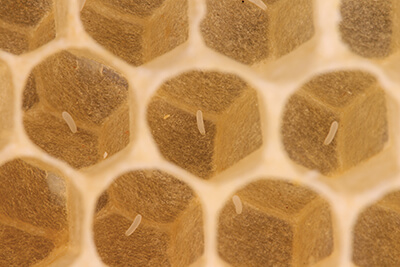
Raising a batch of brood requires a treasure trove of resources and generates a heap of waste. Some folks have estimated that a honey bee larva increases in weight up to 1,500 times during the five-and-a-half-day period from hatching to spinning a cocoon.1 If you had an eight-pound newborn growing at the same rate, it would weigh 12,000 pounds at the end of the five-and-a-half days. Imagine the food. Imagine the diapers. Multiply by thousands.
When you think about the throughput—food in, feces out—you begin to wonder where it all goes. Then there are the eggs, the cocoons, and the brood cappings. Where do they go? And why doesn’t a brood frame smell like a cesspool and look like a dump? In truth, a marvel of biology and waste management is required to make the system the work.
Edible Eggs
I began to think about waste management recently when a beekeeper asked, “What happens to the egg shells?” I immediately remembered the restaurant where I worked as a student. The breakfast cooks cracked eggs and stacked the shells, nestled one inside the other, until they towered two feet above the counter, all glossy and stinky with that peculiar empty-eggshell aroma. I can still smell those sticky turrets.
But honey bee eggs don’t have shells like chicken eggs do. Instead of a hard casing, the eggs of most bees are soft and pliable. They are covered with a membranous, translucent, and flexible material called chorion. Although we say bee eggs “hatch,” the chorion doesn’t rupture in the usual sense. Instead, the chorion dissolves and is absorbed by the larva as it grows.2
Compared to other species, honey bees have very small eggs. Bees that lay one egg on a pollen ball tend to have large eggs, whereas social species that lay many eggs and feed the larvae continually have tiny eggs. The fate of the nursery is also relevant. Species that reuse the nursery, such as honey bees, are more likely to reabsorb the eggs completely, while bees that abandon the nest are more apt to leave the “shells” behind.3
Fun Facts about Feces
Think about a honey bee larva. It floats luxuriantly in a pool of brood food that is continually replenished by the nurse bees. To achieve the rate of growth that honey bee larvae experience, they need to be fed constantly. In fact, honey bee larvae are fed hundreds of times per day. With all that eating going on, why isn’t their brood food contaminated with their own feces? It’s not like they leave their cells to use the facilities, so what gives?
The system used to control fecal deposition in the nest is similar in nearly all bee species, whether they live in a social community or in a solitary cavity. Basically, the reason they don’t deposit excrement in their food is they can’t. When bees are in the early larval stages, the front part of the digestive system—the part that eats—is not connected to the back half of the system—the part that excretes.4 With such a failsafe system, mistakes don’t happen.
Connecting the Parts
It works like this. You can imagine the digestive system as a series of tubes, each connected on one or both ends. In adults, the bee ingests food into its mouth and then the food proceeds through the alimentary canal to the midgut where most digestion and nutrient absorption takes place. From there, the waste travels to the hindgut where it collects before being excreted.5 In larvae, however, the connection between the midgut and the hindgut is missing. There is no connection whatsoever, so the waste accumulates in the midgut.
The two sections of the gut are not connected until just before the first cocoon is spun. In other words, the larva has finished eating and is about to enter the pupal stage in which no eating occurs. As soon as the attachment is made, the waste travels the rest of the way through the ….


